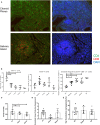The T Cell Receptor Repertoire in Neuropsychiatric Systemic Lupus Erythematosus
- PMID: 32765512
- PMCID: PMC7379895
- DOI: 10.3389/fimmu.2020.01476
The T Cell Receptor Repertoire in Neuropsychiatric Systemic Lupus Erythematosus
Abstract
Objective: In systemic lupus erythematosus (SLE), widespread T cell infiltration into target organs contributes to inflammation and organ damage. Autoreactive T cells become aberrantly activated in this disease due to dysfunctional T cell receptor signaling that lowers the activation threshold. Characterizing the T cell repertoire can provide further insight into the specific homing and proliferation of these T cells into lupus target organs. In the spontaneous lupus model, MRL/lpr, the TCR repertoire has not been fully elucidated, especially for T cells infiltrating the brain. Our aim was to investigate and compare the TCR repertoire between MRL/lpr mice and its congenic controls, MRL/MpJ, and within MRL/lpr tissues. Methods: Spleen, salivary gland, and brain choroid plexus were isolated from female MRL/lpr mice and MRL/MpJ mice. The TCRβ CDR3 region was analyzed by multiplex PCRs and sequencing. Results: Significant differences were seen not only between the MRL/lpr and MRL/MpJ spleens, but also between MRL/lpr tissues. The TCR repertoire in MRL/lpr choroid plexus tissues had significantly increased clonality and sequence homology compared to MRL/lpr spleen and salivary gland. The consensus sequence, CASSQDWGGYEQYFF, was identified in the MRL/lpr choroid plexus repertoire. Conclusions: The TCR repertoire in lupus prone mice is not uniform between target organs, and suggests that T cells are specifically recruited into the choroid plexus of MRL/lpr mice. Further studies are needed to determine the antigen specificities for these infiltrating T cells in target organs of lupus mice, and their possible contribution to the pathogenesis of neuropsychiatric disease and other lupus manifestations.
Keywords: MRL/lpr; T cell receptor; choroid plexus; neuropsychiatric lupus; salivary gland; systemic lupus erythematosus.
Copyright © 2020 Moore, Huang, Jain, Chalmers, Macian and Putterman.
Figures




References
Publication types
MeSH terms
Substances
Grants and funding
LinkOut - more resources
Full Text Sources

